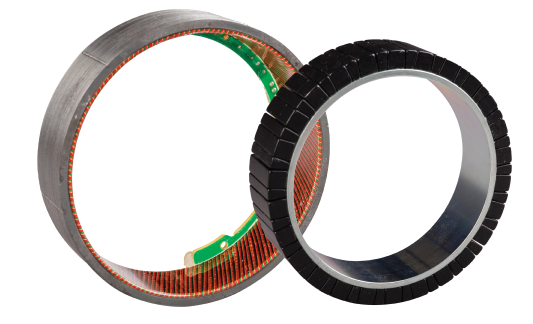
A torque motor is typically a frameless motor used in an application that is mainly for torque control with at very slow or zero speed. Applying torque is a basic function of any permanent magnet motor (brush or brushless). The torque motor can be multiple phase or single phase, depending on the application. If the angle of motion is less than 30 degrees a single phase LAT, (Limited Angle Torque), device is easy to control with just two wires. For larger angles, three phase devices are more typical and can be commutated by a traditional brushless servo driver. Sierramotion customizes torque motors to the limited angle or continuous rotating applications.
Optional Diameters
Diameters from 8mm to 2 meters are possible and depend on the requirements.
Low profile axial length
Depending on torque requirements torque motors can be as thin as 10mm in axial length. Going down below 10 mm is most like a switch to a Sierramotion axial airgap construction.
Torque linearity
Operating a torque motor implies that torque will be controlled by current. Having a linear relationship between torque and current is preferred in the servo control system. Most motors with iron do not have linear torque versus current curves due to saturation. Sierramotion will modify the design for linearity within the operating range while minizing or eliminating cogging torque.
Large aperture or through hole configurations
Most torque motors have a through hole that can be used for a shaft, or for running cables and optics through.
Low impedance
When operating at 24 volts or less motor resistance and inductance can really hurt efficiency and operation. Sierramotion offers very low resistance as low as < 0.050 Ohms in some applications. This limits the voltage drop across the motor. Inductance is usually at a similar level of milli-Henry.
Optional encapsulation
If torque motors are used in vacuum or in mainly conductive environments, encapsulating the coils with a thermally conductive epoxy can increase the thermal time constant and lower thermal resistance.
Torque Motor specifications
Motor configurations are optimized to the application. “Off the shelf” motors were all originally customized to some application before they became available. This used to be an advantage with shorter lead times and lower price. This rule is no longer true, it is possible to get a custom design in the time it takes to get a “standard” product.
| Specifications | |
|---|---|
| Diameter range | 8mm to 2000mm |
| Axial length range | 10mm to 400mm |
| Torque range | 0.001 NM to 1000 NM |
| Low Voltage operation | 12-24 volts |
| High voltage operation | 300-600 volts |
| Torque linearity | <1% error |
| Cogging torque | Minimized with zero cogging options |
Frequently asked questions
No, most torque motors are three phase machines, and others are single phase devices (with limited angle of travel). There are many motor driver options to drive torque motors. For low power single phase devices and simple home grown controller can also be made.
Torque motor diameter is not limited up to about 1 meter. At that point a modular construction is preferred for cost effectivity and handling/shipping. At the large sizes a modular arc shaped segmented motor can easily be produced.
Torque motors can me design to have through holes at 80% of the outside diameter in sizes of 100mm diameter and up. This thin radial cross section motors are optimized for thrusters and impellers where fluids will flow through the center of the rotor.
Torque motors are typically frameless and have a large diameter and a short length. Servo motors are usually a complete housed motor with a shaft, internal encoder and connectors. Servo motors would be the opposite form factor smaller diameter and longer axially.
There are elements of efficiency that are still important, like motor constant Km. If the Km is lower, the motor will have higher resistance and therefore take more voltage to reach a desired current. This can really limit things on smaller motors. Otherwise, efficiency greatly depends on speed, because power output is torque * speed and with zero speed you will have zero efficiency. The real answer is no, but you should consider the motor’s Km.

